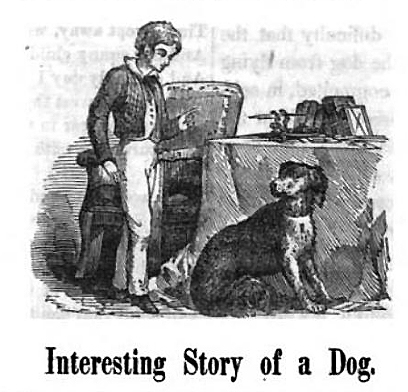[ Samuel G. Goodrich, ed. / Robert Merry's Museum ]
Robert Merry's Museum was an annual miscellany for children and young adult readers, collecting and reprinting material that had been previously published in various books and journals. "Robert Merry" was a fictional traveler and "host" of the Museum, which ran from 1841 - 1872. more info...
Samuel Griswold Goodrich (1793 - 1860) was an American editor and author, primarily of children's works; he edited Merry's Museum from its inception until 1854. Goodrich was extremely successful as a writer and editor; later in his life he served in politics.
Volume 13 of Merry's Museum, published in 1847 (New York: G. W. & S. O. Post), contained an entry labelled "Newfoundland Dog" (p. 55) which simply retells an anecdote first found in Louis Anspach's A History of the Island of Newfoundland (1819) and repeated in several other works.
ONE of the magistrates in Harbor Grace, in Newfoundland, had an old dog, of the regular web-footed species peculiar to this island, who was in the habit of carrying a lantern before his master, at night, as steadily as the most attentive servant could do; stopping short when his master made a stop, and proceeding when he saw him disposed to follow. If his master was absent from home, on the lantern being fixed to his mouth, and the command given, "Go fetch your master," he would immediately set off and proceed directly to town, which lay at the distance of more than a mile from his master's residence; he would then stop at the door of every house which he knew his master was in the habit of frequenting, and, setting down his lantern, growl and strike the door, making all the noise in his power, until it was opened. If his master was not there, he would proceed farther, in the same manner, until he had found him. If he had accompanied him only once into a house, this was sufficient to induce him to take that house in his round.
Volume 14 (Nov. 1847, pp. 167 - 168) contains the following "Interesting Story of a Dog"; its source is credited only as "Canada Paper." This illustration, which seems to have no particular connection to the "Interesting Story," accompanied the piece.

ON Saturday night, (September, 1840,) a man residing in East Market Street found, in that part of the city called Moore's Survey, a child six or eight years of age, sitting on the road, crying bitterly. The child was attended by a Newfoundland dog, which attempted to pacify its companion by lying beside him and licking his face. The man took the child in his arms, and brought him to the engine-house, thinking that the parents arould be more likely to hear of their child there than any other place. The dog followed quietly, and upon Mr. Rykman, whose humanity is well known, making a bed for the child, the dog testified its delight by jumping about the room and licking the host and child alternately. The boy being comfortably bedded for the tight, the dog took his post beside him, and could not be coaxed from the spot.
During the night, Mr. Rykman had occasion to go into the room; but the moment he crossed the threshold, the dog, which was so docile when he left, became furiously enraged, and actually drove him out of the room. Neither coaxing nor scolding had the slightest effect upon the faithful animal; he had taken the child under his protection, and appeared determined to perform his duty. Early in the morning, another of the family, who was not aware that they had visitors, went into the room, but had hardly placed a foot inside when he was furiously attacked by the dog, and compelled to decamp. Before doing so, however, he seized a chair to defend himself, and broke it to pieces over the dog, without producing any other eflect than rendering it more savage and determined than before.
Finding it impossible either to get into his room or coax the dog out of it, or awaken the child, Mr. Rykman procured assistance, and an entry was effected simultaneously by the door and window. Still he remained resolute; he would permit no one to approach the child, and it was actually necessary to beat him severely with clubs ere he could be driven out of the house. This being eflected, the dog started off as rapidly as it could, and, in the course of a couple of hours, returned, accompanied by the child's mother, jumped into the room, and began licking and fondling its little companion! Even then it was with difficulty that the woman could prevent the dog from flying at those who had been compelled, in self-defence, to beat and drive him from the house. The woman said she had been in search of the child all night, without success, and that, in crossing the common near Dundurn, she saw the dog following her at the top of his speed.
Upon reaching its mistress, the faithful animal immediately caught her by her dress, and began pulling her in the direction of the town. The woman, aware of the intelligence of the animal, and knowing that it had accompanied the boy when he strayed from home, followed, in the certainty that she would be taken to her child, whether dead or alive. Nor was she disappointed. The woman lives on a point beyond the marsh, at least two miles from the town, and she thinks that the dog, on leaving the engine-house, went straight home, and, finding its mistress absent, got upon her track, and followed it until he found her. Not the least interesting fact that we have to narrate, in this rambling sketch, is, that the moment the woman and child left the house, the dog became perfectly quiet, and even made advances towards a reconciliation with those he had so savagely assailed a few hours before.

